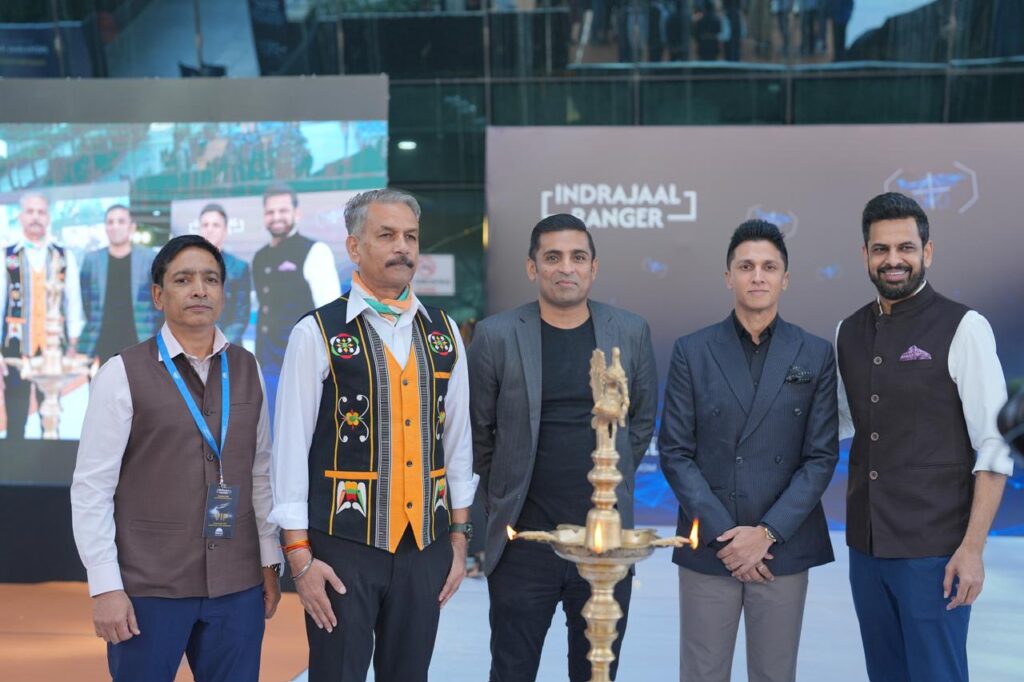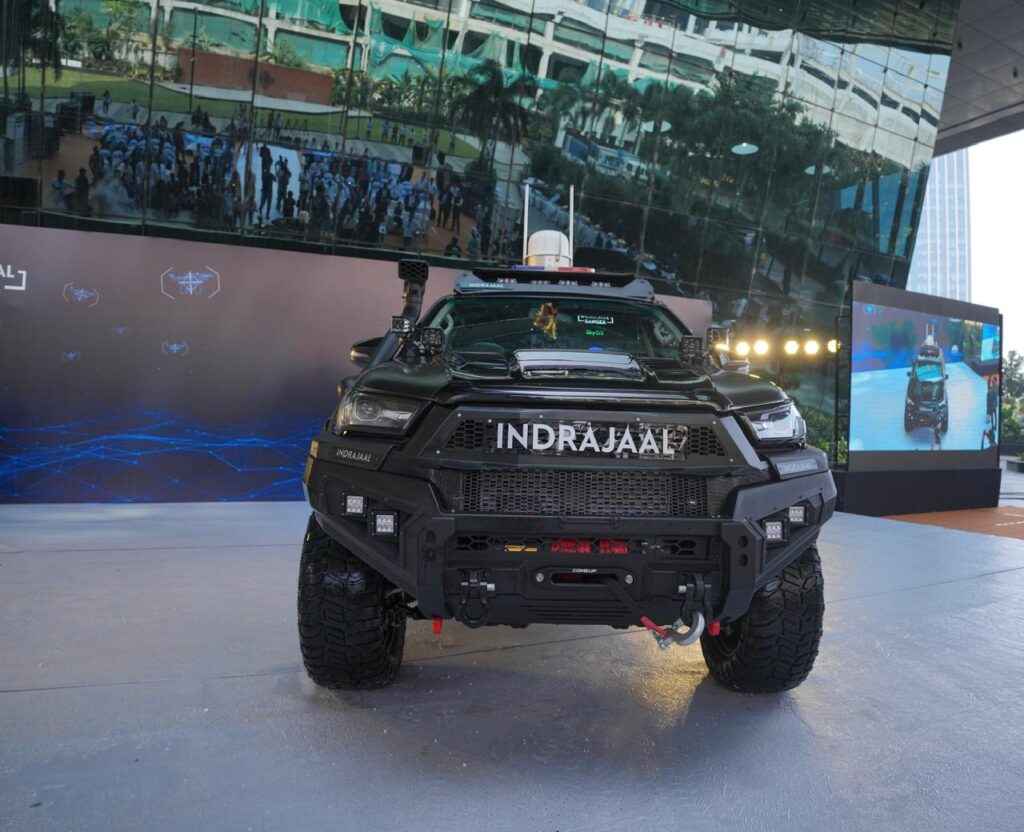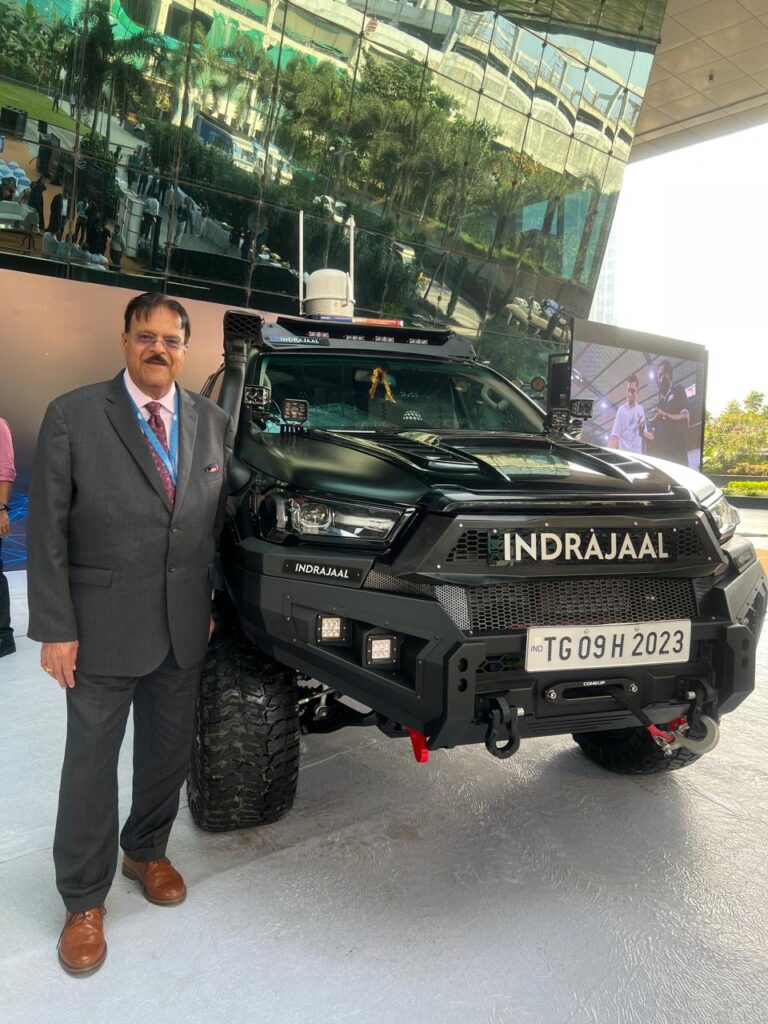Kamal Shah
India has taken a bold and decisive step into the future of security technology with the launch of its first Anti-Drone Patrol Vehicle (ADPV) — the Indrajaal Ranger. This revolutionary, AI-powered mobile counter-drone platform promises to transform how the nation perceives, patrols, and protects itself against the growing menace of aerial threats. Far removed from traditional vehicle-mounted systems that remain stationary for operation, the Indrajaal Ranger is built to fight while on the move — detecting, tracking, and neutralising drones across borders, cities, and critical infrastructure corridors.
A Response Born of Urgency
The birth of the Indrajaal Ranger is not just a story of innovation — it’s a response to necessity. Two alarming national security incidents sparked this technological revolution. The first, an ISI-linked cross-border drone-trafficking case, revealed how smugglers were exploiting drones to deliver weapons into India’s heartland. The second, the neutralisation of 255 Pakistani drones by the Border Security Force (BSF) in a single year, further underscored the magnitude of the challenge. Together, these events made one fact undeniable: India needed a fast, mobile, and intelligent defence system capable of real-time threat interception — a system designed to save lives with every mission.
Engineering Excellence on Wheels
Breaking away from the limitations of static anti-drone systems, Indrajaal’s engineers reimagined what mobile defence could look like. The Indrajaal Ranger embodies technological agility, featuring:
– On-the-move detection of airborne threats
– Real-time patrolling and surveillance across borders and cities
– AI-driven threat analysis ensuring automated, rapid-response action
– Instant interception and neutralisation of rogue drones
– Seamless geographic adaptability, from border roads to dense urban spaces
This integrated mobility allows it to operate as a “digital guardian,” ensuring continuous situational awareness and protection. For India’s defence forces, it means fewer blind spots, faster response times, and unprecedented counter-drone coverage spanning both terrain and time.

Voices of Vision and Valor
At the launch event in Hyderabad, Lieutenant General Devendra Pratap Pandey (Retd) lauded the innovation, emphasizing its profound social and strategic impact. His words resonated with pride and foresight: “India’s youth deserve a safer nation, free from the shadow of international crime networks. Technologies like the Anti-Drone Patrol Vehicle are not just machines — they are shields protecting our children, our farmers, and our future.” His remarks captured what the Ranger symbolizes — courage fused with compassion, and defence merged with duty.
Echoing this sentiment, Kiran Raju, Founder & CEO of Indrajaal, reiterated the company’s mission with clarity and conviction: “Each drone neutralised translates to lives protected and India’s internal security strengthened. This is our primary mission at Indrajaal — to defend freedom.”
Saving Lives at Scale
Beyond its engineering marvel, the Ranger’s social and national implications are profound. By intercepting drones that carry narcotics, weapons, or surveillance payloads, the system effectively breaks the logistical backbone of smuggling and extremist networks. This means fewer drugs infiltrating rural communities, fewer illegal weapons on city streets, and greater peace of mind for border villagers who have long lived under the shadow of cross-border crime.
Moreover, its autonomous operation and AI-driven intelligence reduce the operational burden on the police and BSF, enabling smarter deployment of human resources. Each mission conducted by the Ranger, therefore, represents not only an act of protection but also a step toward more efficient, technology-driven national security.

Indrajaal: Shaping the Future of Autonomous Defence
In an era where the skies themselves have become new battlegrounds, Indrajaal stands as India’s pioneering force in building the future of air defence. As the first autonomous Counter-UAS (Unmanned Aerial Systems) and air-defence company in the nation, Indrajaal is redefining how countries safeguard their borders, critical infrastructure, and urban spaces against the ever-evolving threat of rogue drones. What once seemed the stuff of science fiction—self-defending, intelligent protection systems—is now an Indian reality.
Built upon over a decade of relentless research in Artificial Intelligence, robotics, and autonomous systems, Indrajaal delivers a comprehensive, AI-driven defence architecture that both detects and neutralises threats before they can cause harm. Its advanced systems work seamlessly across vast, complex terrain, providing unmatched situational awareness and lightning-fast response capabilities. At the core of this revolutionary technology lies SkyOS™, Indrajaal’s proprietary autonomy engine—a marvel of modern engineering and AI design. SkyOS™ brings together multi-sensor intelligence, real-time analytics, and autonomous action within a unified C5ISRT framework (Command, Control, Communications, Computers, Intelligence, Surveillance, Reconnaissance, and Targeting). Through this platform, Indrajaal creates adaptive “security domes” over critical zones—be it airports, borders, seaports, refineries, or even entire cities—ensuring an invisible yet invincible shield from aerial threats.
What truly sets Indrajaal apart, however, is not just its technology but its proven impact. The company has already showcased tangible success in live operations with the Indian Armed Forces and national security agencies, intercepting multiple hostile drones in real-world environments. These milestones are not merely technical demonstrations—they represent a transformation in India’s strategic defence capabilities. With ARDTC certification for Counter-UAS deployment, Indrajaal is uniquely positioned to roll out nationwide defence systems that are both scalable and cost-effective, making it a powerful asset for India’s security ecosystem.
Indrajaal’s innovation story did not emerge in isolation. Its strategic partners have played an integral role in shaping its technological and operational foundation. Grene Robotics, the visionary R&D powerhouse behind Indrajaal, brings years of expertise in developing AI-driven, autonomic systems that learn and adapt in real time. Sigma Advanced Systems, with three decades of excellence in defence engineering, empowers Indrajaal with robust avionics, radar, and communication technologies. Supporting this powerful combination are India Accelerator and Finvolve, partners that amplify the company’s growth through mentorship, entrepreneurial support, and innovative investment ecosystems. Together, they compose a consortium that blends deep-tech innovation, engineering precision, and forward-looking entrepreneurship.
The creation of Indrajaal’s ground-breaking technologies also stems from a stark and urgent reality. In recent years, India’s borders have seen a disturbing rise in drone-based smuggling of narcotics, weapons, and explosives—particularly across the western and northern frontiers. The data is alarming: in 2024 alone, over ₹25,000 crore worth of drugs were seized, marking a 55% surge from the previous year. Among these, the western border accounted for nearly half of all heroin confiscations nationwide. Over 200 drones, many carrying arms and contraband, were intercepted in a single year—a chilling testament to the scale of the threat.
Confronted with this escalating menace, Indrajaal answered the call with decisive innovation—the Indrajaal Ranger, India’s first mobile anti-drone patrol vehicle. Tailored to counter cross-border aerial threats, this agile and intelligent platform symbolizes the coming of a new age in national security: one where autonomous systems stand guard, tirelessly defending against unseen dangers from the sky.
Ultimately, what makes Indrajaal truly extraordinary is its vision—to build autonomous defence for a free and safe world. As both a technological pioneer and a guardian of sovereignty, Indrajaal represents the best of Indian innovation and determination. With every deployment and every new milestone, it reaffirms India’s position on the global security map—not as a follower, but as a world leader in autonomous defence.
India today confronts an adversary that transcends traditional boundaries—a silent and swift invader that hovers invisibly across the skies. In the evolving theatre of national security, unmanned aerial systems have reshaped the very nature of threat perception and response. As Kiran Raju, Founder and CEO of Indrajaal, highlighted, “India is facing a new kind of enemy—one that flies.” The rise in drone-based smuggling and cross-border infiltration has transformed what was once a localized concern into an expansive national security challenge. Just days ago, the Delhi Police uncovered an ISI-linked gun-running network employing drones to ferry Turkish PX-5.7 pistols, foreign semi-automatic firearms, high-purity heroin and methamphetamine, ammunition, and even improvised explosive device components. This illicit aerial supply chain, stretching from Pakistan through Punjab, Haryana, and Uttar Pradesh to the heart of Delhi and beyond, underscores a chilling new reality: the threat is airborne, rapid, and geographically unrestrained.
Indrajaal Ranger—the nation’s pioneering anti-drone patrol vehicle—emerges as a direct and decisive response to this challenge. Built on a rugged 4×4 platform and powered by the proprietary SkyOS™ autonomy engine, it delivers a transformative approach to aerial threat management. With a detection range of up to 10 kilometres and a mitigation capability of 4 kilometres, the vehicle integrates multi-sensor detection, AI-powered tracking, and cyber and kinetic countermeasures, including hard-kill “Zombee” interceptor drones. Its advanced operational features—long-range detection, GPS-denied resilience, and cyber takeover capabilities—equip security forces to pre-empt, identify, and neutralize intrusions in real time. For border security and counter-terrorism operations, the Indrajaal Ranger functions not merely as a defensive instrument but as an intelligent combat system, capable of maintaining vigilance across complex terrain and dynamic threat scenarios.
The vehicle’s applications extend well beyond the frontiers. In urban policing and event security, it provides 360-degree situational awareness, geofencing of restricted airspace, automated violation detection, and integration with metropolitan command centres—ensuring city safety during mass gatherings and high-profile events. In protecting critical infrastructure and high-value convoys, its rapid-deployment configuration forms a moving defensive bubble around airports, ports, refineries, industrial corridors, government campuses, and spiritual or political landmarks, all without the need for fixed installations. Unlike conventional vehicle-mounted anti-drone systems, which operate effectively only when stationary, the Indrajaal Ranger represents a paradigm shift—it is a mobile fortress that operates as both a sensor and a shield, dynamically adapting its defences while in motion. Each patrol movement thus transforms into a real-time engagement capability, redefining the concept of aerial perimeter security.
In essence, the Indrajaal Ranger embodies the convergence of defence engineering, artificial intelligence, and autonomous mobility to address the most insidious form of modern warfare. It transforms a vehicle into an intelligent, self-reliant combat platform, ensuring that India is no longer a passive observer of aerial incursions but a proactive guardian of its own skies. As drone warfare becomes the defining vector of twenty-first-century security threats, the Indrajaal Ranger stands as a symbol of technological sovereignty and strategic readiness—India’s vigilant sentinel in an era where the enemy, indeed, flies.

A New Chapter in India’s Defence Story
The arrival of the Indrajaal Ranger marks more than just a product launch — it signals a paradigm shift in how India defends its skies and safeguards its sovereignty. This fully indigenous innovation stands as a testament to the nation’s growing technological strength and its unyielding commitment to security innovation.
With the Ranger now rolling out across borders and corridors of strategic importance, India is better equipped than ever to respond to emerging threats — swiftly, intelligently, and decisively. The message is clear: India’s skies are no longer open to hostile eyes. The era of the mobile, AI-driven defender has begun — and it’s called the Indrajaal Ranger.


